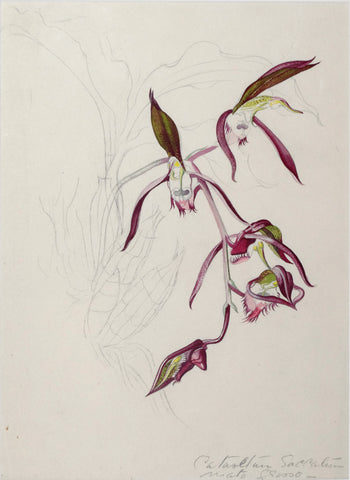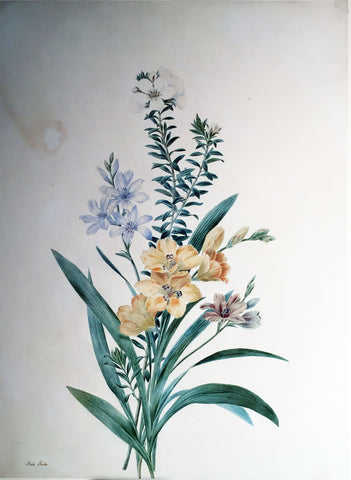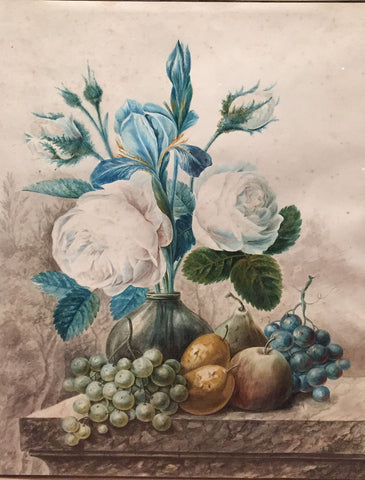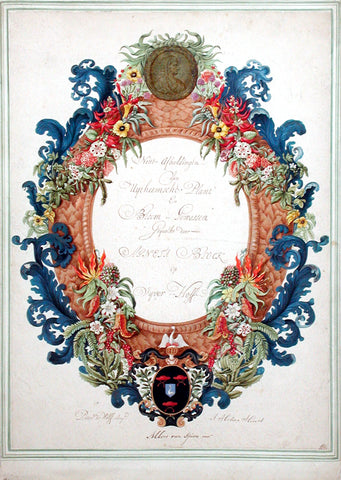
Margaret Mee (British, 1909-1988), Catasetum Saccatum
Catasetum Saccatum
Gouache over pencil on paper
Watermarked CM Fabriano --11/11 cotone
Image size: 8 1/2 x 12 in
Provenance: Margaret Mee
This sketch is possibly connected to a sketch in Mee’s notebook of 1962-1965 of a Catasetum saccatum collected in the Mato Grosso (cf. S. de Botton Brautigam, ed. Margaret Mee (Rio de Janeiro: 2006) pp. 252 and 356) and the frontispiece painting of a Catasetum saccatum in her Flowers of the Brazilian Forest (London: 1968), which is dated August 1963 and depicts a specimen collected on the Rio Alto Juruena in the northern Mato Grosso, during her second expedition of 1962. In her notes accompanying a later painting of a Catasetum saccatum, Mee describes it thus: “the masculine flowers of this strangely beautiful plant are completely different from the female flowers, imitating dark bats with outspread wings. The long pendent stem supported more than fifteen blooms. The modest female flowers resemble the green hoods of elfins, growing on an erect stem. Both forms grow on the same plant and even from the same pseudo-bulb. Until Charles Darwin pronounced them to be the same species, they were considered to be different plants.” (Flores do Amazonas. Flowers of the Amazon (Sao Cristovao, Rio de Janeiro: 1980), no.16)
MARGARET MEE (BRITISH, 1909-1988)
Unlike Amazon botanical artists before her, Margaret worked entirely from living plants. Her fifteen expeditions into the interior, mostly to Amazonia, involved traveling and living under the most primitive conditions. She would draw at night by torchlight to capture rare nocturnal flowers, and this immediacy gave her paintings an accuracy, depth, and color unrivaled by her predecessors. Her travels coincided with the beginning of the commercial exploitation of the forest, and she expressed her fury at the damage caused to the land and its peoples” (DNB).
Mee’s magnificent botanical paintings, most based on specimens collected during her own expeditions, includes several illustrations and descriptions of plants either recently discovered (one by Mee herself) or never previously illustrated, as explained in the preface by Sir George Taylor, Director of the Royal Botanic Gardens at Kew, who compares Mee’s paintings favorably to the work of her predecessor C.F. P. von Martius, author of the Flora brasiliensis (1840-1906). 17 plant families are represented, with each section introduced by one of 10 different botanist contributors. The plates are accompanied by detailed part-scientific, part-anecdotal descriptions by the artist. Some are quite poignant, for Mee experienced first-hand the tremendous losses to the world’s ecological resources that began occurring in the 20th century. Noting, for example, that in previous years she was able to find the rare Brazilian orchid Laelia purpurata “in the swampy forests around Ubatuba,” she deplores the fact that “these wonderful coastal forests are being steadily destroyed, often for use as firewood! With them perish untold numbers of animals and plants. So the advance of civilisation and industrialization proceeds at the cost of the total destruction of all that is most beautiful and precious in creation” (text to Plate 13).
Margaret Mee was in her forties when she first visited Brazil with her husband Greville Mee. They moved there soon after, and it was at the age of 47 that she made her first expedition up the Amazon. Over the next 32 years, she made a number of further trips up the Amazon and in coastal areas of Brazil, some of them lasting for four months. During these years, she continued to paint and draw what she saw and kept diaries of her travels, later published. In 1988, at the age of 79 and shortly after completing another Amazon trip, Mee came to England to lecture to the Royal Geographic Society and to attend the opening of an exhibition of her paintings at the Royal Botanic Gardens, Kew.
or by email at loricohen@aradergalleries.
We Also Recommend





